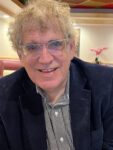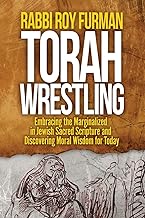Torah Wrestling: Embracing the Marginalized in Jewish Sacred Scripture and Discovering Moral Wisdom for Today by Rabbi Roy Furman; Read the Spirit Books; (c) 2025; ISBN 9781641-902086; 164 pages; $21.
By Rabbi Michael Leo Samuel

 CHULA VISTA, California — Rabbi Roy Furman’s Torah Wrestling is a masterful and engaging exploration of the Torah’s timeless wisdom, offering readers a fresh and dynamic approach to understanding its teachings in the context of modern life.
CHULA VISTA, California — Rabbi Roy Furman’s Torah Wrestling is a masterful and engaging exploration of the Torah’s timeless wisdom, offering readers a fresh and dynamic approach to understanding its teachings in the context of modern life.
Furman, a seasoned rabbi and educator, combines scholarly insight with relatable storytelling, making this book a valuable resource for both experienced Torah students and those new to Jewish scripture. The title, Torah Wrestling, is particularly fitting, as Furman invites readers to actively engage with the text, embracing the Jewish tradition of chavruta (study partnership) to grapple with its complexities and uncover its deeper meanings.
One of the book’s strengths lies in its structure. Each chapter focuses on a specific Torah portion or theme, providing a detailed analysis while connecting it to contemporary issues. For example, in his discussion of the story of Cain and Abel (Genesis 4), Furman delves into the nature of jealousy and conflict, drawing parallels to modern societal divisions. He challenges readers to reflect on their own relationships and responsibilities, asking, “How do we respond when envy or anger threatens to consume us?” This blend of ancient narrative and modern application is a recurring theme throughout the book, making the Torah’s lessons both accessible and relevant.
Another standout chapter explores the Binding of Isaac (Genesis 22), a story that has puzzled and troubled readers for centuries. Furman approaches this challenging text with sensitivity, examining themes of faith, obedience, and moral ambiguity. He poses thought-provoking questions, such as, “What does it mean to trust God in the face of uncertainty?” and “How do we reconcile divine commands with our own moral compass?” Furman’s nuanced analysis encourages readers to wrestle with these questions rather than seeking easy answers, embodying the spirit of the book’s title.
Furman also shines in his discussion of the Exodus narrative, particularly the themes of freedom and responsibility. He highlights the Israelites’ journey from slavery to Sinai, emphasizing that true freedom is not merely the absence of oppression but the willingness to embrace a higher purpose. Drawing on modern examples, such as the struggles for civil rights and social justice, Furman illustrates how the Torah’s message of liberation continues to resonate today. His insights are both inspiring and practical, urging readers to consider how they can contribute to a more just and compassionate world.
The book’s inclusivity is another notable feature. Furman acknowledges the diversity of perspectives within Judaism and beyond, creating a space for readers of all backgrounds to find meaning in the Torah. For instance, in his exploration of the Ten Commandments, he emphasizes their universal relevance, discussing how principles like honoring parents and avoiding falsehoods apply to people of all faiths. This inclusive approach makes Torah Wrestling a valuable resource for interfaith dialogue and personal reflection.
Furman’s writing is both scholarly and conversational, blending insightful commentary with relatable anecdotes. In one chapter, he shares a personal story about a congregant struggling with forgiveness, using it to illustrate the Torah’s teachings on reconciliation and healing. These moments of vulnerability and authenticity make the book feel deeply personal, inviting readers to see themselves in its pages.
In Torah Wrestling, Rabbi Roy Furman has crafted a work that is intellectually stimulating, spiritually enriching, and profoundly practical. It is a testament to the enduring power of the Torah to inspire, challenge, and transform. For people seeking to deepen their understanding of scripture and its application to modern life, this book is an essential read. Furman’s ability to make ancient wisdom feel immediate and relevant is a gift, and Torah Wrestling is a must-read for anyone on a journey of spiritual and moral growth.
Rabbi Furman’s talk on Parshat Bereishit, delivered after the High Holy Days, focuses on Genesis 1-3, exploring the creation narratives and their implications for gender equality and human agency. He begins by noting the Torah’s cyclical reading, rolled back from Moses’ death to the world’s creation, and highlights Rashi’s question: why does the Torah start with creation rather than the laws of Passover? Furman sees this as an invitation to interrogate the text. He contrasts the two creation accounts: Genesis 1 presents humans, male and female, as equals created in God’s image (btselem Elohim), capable of discerning good from evil, while Genesis 2 depicts a patriarchal reality where woman is created from man’s rib as a secondary, unequal being. Traditional interpretations, like the midrash of Lilith as Adam’s rebellious first wife, attempt to reconcile these accounts, but Furman views Genesis 1 as an egalitarian ideal and Genesis 2 as the unequal social context humans must overcome.
Rabbi Roy Furman and I share a profound mutual passion for delving into the rich tapestry of philosophical issues intricately woven throughout the Torah. His approach, as evidenced in his writings and talks, resonates deeply with my own conviction that the Hebrew Bible is not merely a collection of historical narratives and legal pronouncements, but a profound source of enduring philosophical inquiry. Personally, I found his insights to be not only refreshing in their originality but also deeply important in their capacity to illuminate the text in novel and meaningful ways for contemporary thought. His ability to extract and articulate the underlying philosophical frameworks within the Torah provides a vital service for those seeking a more nuanced and intellectually engaging understanding of its teachings.
Reading the Bible from a philosophical perspective holds significant importance for several key reasons. Firstly, it allows us to move beyond a purely literal or theological interpretation, engaging with the text on a deeper intellectual level. By examining the ethical dilemmas, existential questions, and concepts of justice, morality, and human nature presented within the Bible, we can uncover layers of meaning that might otherwise remain hidden. This philosophical lens encourages critical thinking and fosters a more active and engaged relationship with the text.
Secondly, a philosophical approach highlights the enduring relevance of the Bible to contemporary issues. The fundamental questions explored within its narratives and laws – questions about the nature of good and evil, the meaning of life, the responsibilities of individuals within a community, and the relationship between humanity and the divine – remain central to philosophical discourse today. By engaging with these ancient texts through a philosophical framework, we can gain valuable insights and perspectives that can inform our understanding of modern ethical and societal challenges.
Finally, a philosophical reading of the Bible fosters a broader and more inclusive dialogue. By focusing on the universal philosophical themes embedded within the text, it can create a common ground for discussion and understanding among individuals from diverse religious and secular backgrounds. This approach emphasizes the shared human quest for meaning and purpose, allowing for a richer and more nuanced appreciation of the Bible’s enduring contribution to Western thought and its continued relevance in shaping our understanding of ourselves and the world around us. Furman’s work, in particular, exemplifies the power of this approach, making the ancient wisdom of the Torah accessible and intellectually stimulating for a contemporary audience.
Although the book is only 164 pages, it is my hope that Rabbi Furman will continue writing more books on the weekly parsha. He is a gifted teacher.
*
Rabbi Dr. Michael Leo Samuel is spiritual leader of Temple Beth Shalom in Chula Vista, California.